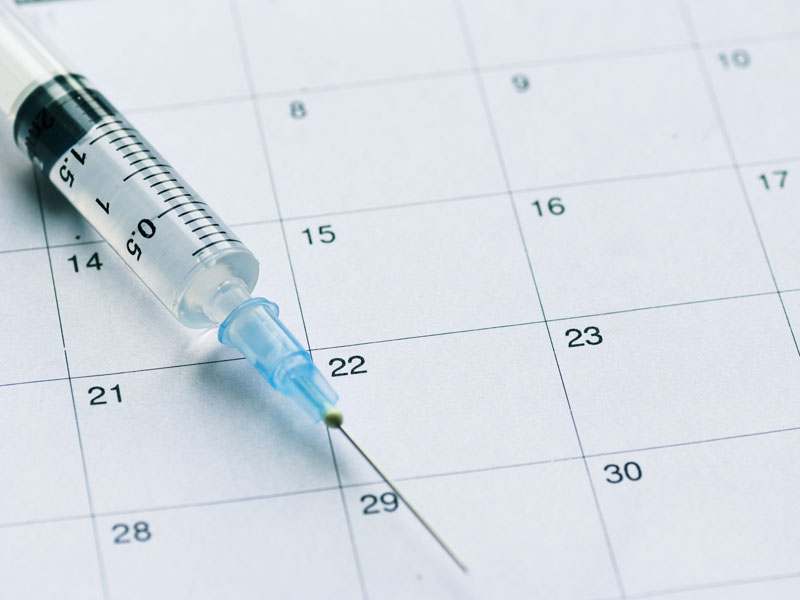Check Your Mail!
Latest AAFP Immunization Materials Keep FPs Up to Date
May 11, 2021, 8:49 a.m. Michael Devitt — AAFP members, it’s time to check your mail. The Academy is sending the latest immunization resources your way.

At the end of April, the Academy began mailing all active members laminated, full-color copies of the 2021 adult, childhood/adolescent and catch-up recommended immunization schedules that were developed by the CDC’s Advisory Committee on Immunization Practices in conjunction with the AAFP and other medical specialty organizations.
Members can also access the immunization schedules on the AAFP mobile app or through the Shots Immunizations App, which was developed by vaccine experts from the Academy and the Society of Teachers of Family Medicine.
Funding to print and mail the immunization schedules was provided by a grant from Merck & Co. Inc.
The immunization materials, delivered to members in print and electronically each year, serve a number of purposes. In addition to providing family physicians with the latest vaccine-related information and joint recommendations from the AAFP, ACIP and other medical organizations, they are a valuable communication tool that FPs can share with patients as they discuss the importance of immunizations. This type of communication is especially important today, given the ongoing COVID-19 pandemic and concerns about vaccine hesitancy and lack of access.
Story Highlights
Schedule Highlights
Pamela Rockwell, D.O., of Ann Arbor, Mich., the AAFP’s liaison to the ACIP, shared many notable revisions to the immunization schedules with AAFP News. Among the changes that family physicians should be aware of:
- MenQuadfi, a vaccine that provides protection against meningococcal serogroups A, C, W and Y, was added to the list of meningococcal vaccines available for individuals 24 months and older.
- Zostavax, a live zoster vaccine, was removed from the immunization schedules because it is no longer available in the United States.
- Shingrix, a recombinant zoster vaccine administered in a two-dose schedule two to six months apart, is the only zoster vaccine available in the United States. It is recommended for all adults 50 years and older regardless of previous herpes zoster or history of zoster vaccine.
- A clarification regarding catch-up vaccination in children with Haemophilus influenzae type b vaccines states that no further doses are recommended if a previous dose of Hib vaccine was administered at age 15 months or older.
- Clarifying language was added regarding the use of live attenuated influenza vaccines for individuals currently taking antiviral medications such as oseltamivir, zanamivir, peramivir and baloxavir.
- Clarifying language also was added regarding the use of tetanus toxoid-containing vaccines for wound management in both children and adults.
- For hepatitis A vaccination, the note was revised to include dosing for the accelerated Twinrix schedule of three doses at zero, seven and 21-30 days, followed by a booster dose at 12 months, for individuals traveling to countries with high or intermediate endemic hepatis A infection rates.
- A two-dose rabies vaccine series, administered at zero and seven days, is recommended for immunocompetent individuals 18 and older for pre-exposure prophylaxis.
COVID-19 Vaccine Status
Rockwell also provided a brief overview of vaccines for COVID-19. Currently, three vaccines are available in the United States: a two-dose vaccine from Pfizer Inc. and BioNTech SE, which has received an emergency use authorization for individuals 16 and older; a two-dose vaccine from Moderna Inc., which has received an EUA for individuals 18 and older; and a one-dose vaccine from Janssen/Johnson & Johnson, which has also received an EUA for individuals 18 and older.
“Plans to have COVID-19 vaccines available to family physicians to distribute from their offices as major vaccine distribution centers start to close are being made with collaboration of state and local health departments,” Rockwell said. “Physicians interested in distributing COVID-19 vaccines need to enroll as a COVID-19 vaccination provider and must work with their local and state immunization programs.”
“Many studies highlight that patients have trust in their personal physicians and take their physicians’ advice,” Rockwell continued. “Patients should understand that mild side effects such as fever, chills, headache and myalgias are usually limited to one to two days, and are considered ‘normal’ with these vaccines; these side effects indicate a robust immune response to the vaccines. Family physicians should encourage their patients to enroll in the CDC V-Safe text-messaging safety system after receiving their COVID vaccination. Patients can enroll up to 45 days after receipt of their vaccine.”
While the Janssen/Johnson & Johnson vaccine was briefly paused in April based on reports that linked the vaccine with several cases of cerebral venous sinus thrombosis seen in combination with thrombocytopenia, ACIP voted on April 23 to reaffirm its interim recommendation for use of the vaccine and published updated recommendations on April 27, which include a new warning on the risk of thrombosis with thrombocytopenia syndrome in women ages 18 to 49.
“To do our part to help end this historic pandemic through herd immunity, family physicians should continue to give a strong recommendation to vaccinate against the coronavirus and counsel patients with all available data on benefits and risks,” Rockwell said. “Women younger than 50 years should be aware of the rare risk of TTS and counseled that other COVID vaccines options are available to them if they choose. Encourage your patients to get vaccinated wherever the vaccine is available to them.”